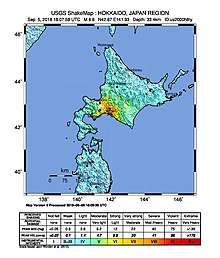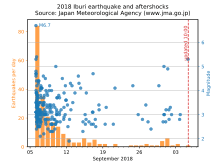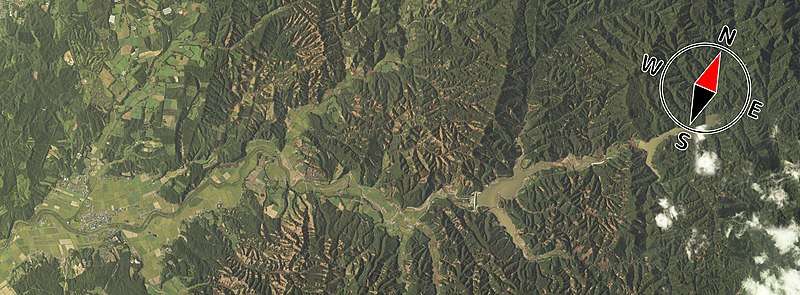2018 Hokkaido Eastern Iburi earthquake
 Sapporo | |
| UTC time | 2018-09-05 18:07:58 |
|---|---|
| ISC event | |
| USGS-ANSS | ComCat |
| Local date | 6 September 2018 |
| Local time | 3:08 a.m. JST |
| Magnitude | 6.6 Mw |
| Depth | 35.0 km (22 mi) |
| Epicenter | 42°40′16″N 141°55′59″E / 42.671°N 141.933°ECoordinates: 42°40′16″N 141°55′59″E / 42.671°N 141.933°E |
| Type | Intraplate earthquake[1] |
| Max. intensity |
IX (Violent) 7 (X–XII (Extreme)) |
| Tsunami | No |
| Landslides | Yes |
| Aftershocks |
129 Largest: Mw 5.4 on 6 September (6:04 a.m. JST)[2] |
| Casualties | 41 dead, about 680 injuries[3] |
An earthquake measuring 6.6 MW on the moment magnitude scale struck Iburi Subprefecture in southern Hokkaido, Japan, on 6 September 2018 at 3:08 a.m. Japan Standard Time. The earthquake's epicenter was near Tomakomai and occurred at a depth of 35.0 kilometres (21.7 mi). The Japan Meteorological Agency (JMA) registered a magnitude of 6.7 Mj and a maximum intensity of 7 on the shindo scale.[4] Shaking from the earthquake was felt strongly in Hokkaido and Aomori Prefecture.[5] The earthquake disrupted electrical service throughout Hokkaido, leaving 5.3 million residents without power. Forty-one people were confirmed dead and around six hundred and eighty were injured.[3] The event is officially known as Heisei san-jū-nen Hokkaidō iburi tōbu jishin (平成30年北海道胆振東部地震, "Hokkaido Eastern Iburi Earthquake of Heisei 30").
Damage and effects
| Date | Time | Households | % | Ref |
|---|---|---|---|---|
| 6 Sep | 3:08 | 0 / 2,950,000 | 0% | |
| 16:00 | 329,000 | 12% | [7] | |
| 7 Sep | 3:00 | 964,000 | 33% | [8] |
| 9:00 | 1,455,000 | 49% | [9] | |
| 12:00 | 1,513,000 | 51% | [10] | |
| 8 Sep | 4:00 | 2,928,000 | 99% | [11] |
The earthquake cut power to all 2.95 million households in Hokkaido. This was because the Hokkaido Electric Power Company's coal-fired power plant in Atsuma was heavily damaged by fires that broke out during the earthquake. The damage to the plant caused an imbalance in the supply and demand of electricity throughout Hokkaido; this resulted in the blackout.[12] By 6:30 p.m. JST on the day of the earthquake, power was restored to 340,000 households in Hokkaido.
All flights to New Chitose Airport were cancelled on the day of the quake. NHK World-Japan announced the airport resumed business at 11:00 a.m. JST the day after the quake. All public transport, including rail, subway, and bus services was shut down in Hokkaido due to the loss of electricity and damages.[13][14] Hospitals were forced to function on emergency backup power, due to the blackout. Many hospitals had to turn away emergency patients because of the outages.[15]
The earthquake caused many roads in Hokkaido to become impassable. Some roads were blocked by debris from landslides, others were destroyed by soil liquefaction as far away from the epicenter as Kiyota-ku, Sapporo.[12] Near the earthquake's epicenter in Atsuma, emergency services could not take emergency calls after the quake due to the heavy damage.[16]
The blackout had a severe impact on the farming and fishing industries in Hokkaido. The prefecture provides half of Japan's raw milk, but without power for refrigeration or operating the milking equipment, the cows could not be milked and the product was wasted. Other produce, such as onions and potatoes, could not be kept cool or shipped away due to the closure of the rail network.[17]
Seismic intensity


The earthquake was the first to have ever reached a maximum level of 7 on the Japan Meteorological Agency seismic intensity scale, or Shindo scale, in Hokkaido[18] and the sixth in Japan since the system was put in place in 1949.
| JMA seismic level (Shindo scale) |
Prefecture | City or municipality name |
|---|---|---|
| 7 | Hokkaido | Atsuma |
| 6 higher | Abira, Mukawa | |
| 6 lower | New Chitose Airport, Hidaka, Biratori | |
| 5 higher | Sapporo, Tomakomai, Ebetsu, Mikasa, Chitose, Eniwa, Naganuma, Shinhidaka | |
| 5 lower | Hakodate, Muroran, Iwamizawa, Noboribetsu, Date, Kitahiroshima, Ishikari, Shinshinotsu, Nanporo, Yuni, Kuriyama, Shiraoi |
Casualties
There have been 41 confirmed deaths resulting from the earthquake. About 680 are injured. Thirty-six of the deaths were in Atsuma.[3] The region was inundated by Typhoon Jebi, the strongest typhoon to hit Japan in a quarter of a century, the day before the earthquake struck. The earthquake triggered landslides in the wet soil the typhoon left behind which killed multiple people.[20]
Response
Prime Minister Shinzō Abe announced that 25,000 members of the Japan Self-Defense Forces would be deployed to Hokkaido to assist in disaster relief efforts. Also, he announced that he would temporarily suspend his campaign to be re-elected as President of the Liberal Democratic Party. His competitor, Shigeru Ishiba, also postponed some campaign activities.[21]
The Japan national football team cancelled a friendly match scheduled for 7 September against Chile in the Sapporo Dome. The team sent their condolences to the victims of the earthquake.[22]
Rescue teams from Aomori Prefecture and Tokyo traveled to Hokkaido by the Seikan ferry to assist in the relief efforts.[23][24]
Nintendo announced that it would postpone its Nintendo Direct series release in light of the disaster.[25]
Facebook activated its safety check in response to the earthquake.[26]

References
- ↑ "平成 30 年北海道胆振東部地震の評価" (PDF) (in Japanese). Earthquake Research Promotion Headquarters Earthquake Investigation Committee. Retrieved 7 September 2018.
- ↑ "M 5.4 – 29km E of Tomakomai, Japan". United States Geological Survey. Retrieved 6 September 2018.
- 1 2 3 平成30年北海道胆振東部地震による被害及び消防機関等の対応状況(第25報) (PDF) (in Japanese). Fire and Disaster Management Agency. 14 September 2018. Retrieved 14 September 2018.
- ↑ "M 6.6 – 27km E of Tomakomai, Japan". United States Geological Survey. Retrieved 6 September 2018.
- ↑ "M 6.6 – 27km E of Tomakomai, Japan: Did You Feel It?". United States Geological Survey. Retrieved 6 September 2018.
- ↑ "設備および停電等の状況について". Hokkaido Electric Power Company.
- ↑ "記者会見発言要旨(9月6日16時現在" (PDF). Hokkaido Electric Power Company.
- ↑ "設備および停電等の状況について(9月7日3時現在)" (PDF). Hokkaido Electric Power Company.
- ↑ "設備および停電等の状況について(9月7日9時現在)" (PDF). Hokkaido Electric Power Company.
- ↑ "設備および停電等の状況について(9月7日12時現在)" (PDF). Hokkaido Electric Power Company.
- ↑ "設備および停電等の状況について". Hokkaido Electric Power Company.
- 1 2 "Hokkaido quake: Landslides bury homes, power cut to millions". The Asahi Shimbun. Retrieved 6 September 2018.
- ↑ "ライフラインの状況(9月6日18:30時点)". Prime Minister's Official Residence (Japan). Retrieved 6 September 2018.
- ↑ "Breaking News at 11:00". NHK World-Japan. Retrieved 7 September 2018.
- ↑ "Quake paralyzes public transport in Hokkaido". NHK World-Japan. Retrieved 6 September 2018.
- ↑ "住宅倒壊などの情報 北海道 厚真町". NHK. Retrieved 6 September 2018.
- ↑ "Farmers, fishers struggling after Hokkaido quake". NHK World-Japan. Retrieved 7 September 2018.
- ↑ "厚真町は震度7 北海道内で史上初の観測 気象庁". Asahi Shimbun (in Japanese). Retrieved 7 September 2018.
- ↑ 北海道胆振地方中東部を震源とする地震について (in Japanese). 日本首相官邸. 6 September 2018. Archived from the original on 6 September 2018. Retrieved 6 September 2018.
- ↑ "Hokkaido earthquake: Eight dead as landslides and power outages hit northern Japan". The Daily Telegraph. Retrieved 6 September 2018.
- ↑ Kaori Kaneko, Chang-Ran Kim. "Powerful quake paralyses Hokkaido in latest disaster to hit Japan". Reuters. Retrieved 6 September 2018.
- ↑ "Japan vs. Chile cancelled after earthquake hits Sapporo". ESPN. Retrieved 6 September 2018.
- ↑ "新幹線運休、青森からフェリーで対岸へ". Mainichi Shimbun. Retrieved 6 September 2018.
- ↑ "東京消防庁 救助の専門部隊 北海道に派遣". NHK. Retrieved 7 September 2018.
- ↑ Martinez, Phillip. "Nintendo Direct Postponed due to Hokkaido Earthquake". Newsweek. Retrieved 6 September 2018.
- ↑ "The Earthquake in Hokkaido, Japan Crisis Response". Retrieved 6 September 2018.
External links
| Wikimedia Commons has media related to 2018 Hokkaido Eastern Iburi earthquake. |